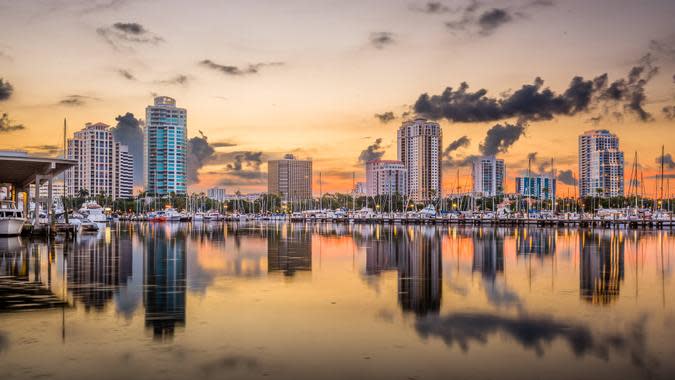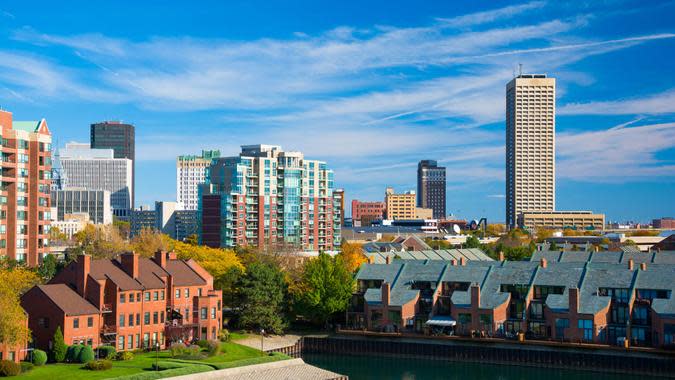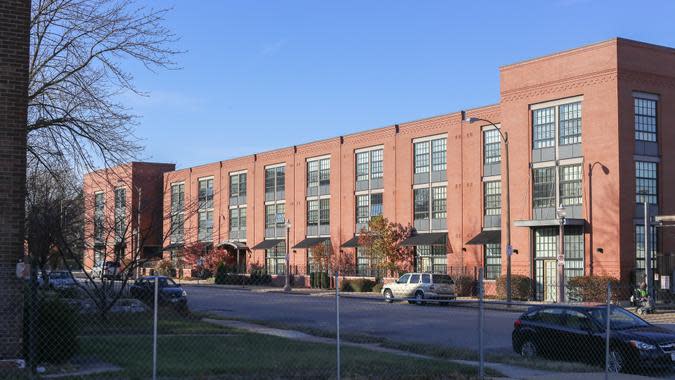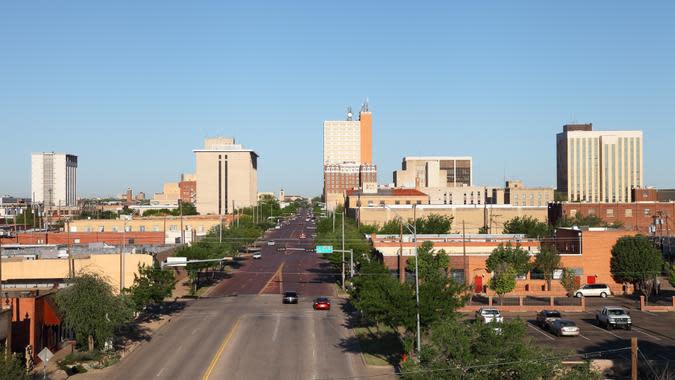50 Cheapest Places To Retire Across America

Retirement should be a time of leisure and relaxation but unfortunately you won’t be doing too much relaxing in the shade if you have to be constantly stressing about money. Most people retire on a limited budget, and often this means seeking a new location to live, where you can stretch your money farther.
Check Out: How Rare Coins Can Fund Your Early Retirement Dreams
Try This: Do This To Earn Guaranteed Growth on Your Retirement Savings (With No Risk to Your Investment)
To pinpoint the cheapest places to retire, GOBankingRates analyzed and ranked the 100 biggest U.S. cities based on the annual retirement income needed to cover basic costs, including housing, healthcare, groceries, transportation and utilities. We also rated cities based on their livability, and only considered cities where the percentage of seniors in the population was 10% or higher. Take a look and see why these are the places where you don’t need to be a millionaire to retire.

50. Raleigh, North Carolina
Total annual expenditures: $53,392.38
Percent of population age 65 and older: 12.20%
Livability score: 74
Raleigh’s cost of living is 2.4% above the national average, but with a livability score of 74, it’s probably worth the slight increase in costs. Healthcare and transportation, at least, are below national average.
Explore More: 9 Ways Frugal Retirees Spend Their Social Security Checks
Find Out: 10 Worst Places in Illinois for a Couple To Live on Only a Social Security Check
Sponsored: Owe the IRS $10K or more? Schedule a FREE consultation to see if you qualify for tax relief.

49. New Orleans, Louisiana
Total annual expenditures: $52,975.26
Percent of population age 65 and older: 16.60%
Livability score: 63
The Big Easy may have an aura that attracts visitors, but its livability score isn’t super high. The cost of living here is 1.6% above the national average but housing and utilities are lower than national average.
Discover More: Here’s the Cost To Retire Comfortably in Every State by Age

48. Madison, Wisconsin
Total annual expenditures: $52,870.97
Percent of population age 65 and older: 13.48%
Livability score: 74
The cost of living in Madison is only 1.4% above average, but its high livability score may make that cost worth it. Groceries, healthcare and transportation are all below the national average.

47. Dallas, Texas
Total annual expenditures: $52,662.41
Percent of population age 65 and older: 11.35%
Livability score: 69
Housing doesn’t come cheap in Dallas. The city’s median home value is $325,315.11. But retirees can save on healthcare and housing, both of which cost less than average here.

46. Arlington, Texas
Total annual expenditures: $52,558.13
Percent of population age 65 and older: 12.51%
Livability score: 77
Arlington ranks high for livability, with a variety of local amenities and affordable local housing. The median home value in this city is $320,019.92. Groceries, healthcare and housing costs are also lower than average in Arlington.

45. St. Petersburg, Florida
Total annual expenditures: $52,349.56
Percent of population age 65 and older: 20.18%
Livability score: 70
The Sunshine City is known for attracting a higher percentage of older adults, so it’s not a surprise that it has one of the higher numbers of seniors on this list. St. Petersburg is definitely a city to consider for retirement, with great weather year-round and beautiful oceanfront views. But you might have to pay a little extra to get those views. The cost of living is a hair above the national average.
Read More: 7 Ways Shopping at Costco Helps Retirees Stick To a Budget

44. Fort Worth, Texas
Total annual expenditures: $52,245.28
Percent of population age 65 and older: 10.30%
Livability score: 73
Fort Worth has an excellent livability score, but it is the first city on the list where the cost of living is a smidge above the national average. Despite that, all expenditures except transportation are under the national average.

43. Spring, Texas
Total annual expenditures: $52,141.00
Percent of population age 65 and older: 9.52%
Livability score: 77
Spring, Texas has a cost of living that is right at the national average. It has the lowest percentage of adults age 65 and older, but a high livability score, which is attractive to retirees.

42. Charlotte, North Carolina
Total annual expenditures: $51,984.58
Percent of population age 65 and older: 11.30%
Livability score: 66
In Charlotte, the cost of living is less than a percent below the national average. All expenditures are under the national average except for housing which is 3.3%, at $19,494.78 per year.

41. St. Paul, Minnesota
Total annual expenditures: $51,411.03
Percent of population age 65 and older: 12.51%
Livability score: 63
Healthcare, housing and utility costs are all below average in St. Paul. And the median home value is not super high either, at $286,186.41
Find Out: Why Florida’s Retirees Are Fleeing — And Where They’re Going Instead

40. Spokane, Washington
Total annual expenditures: $51,411.03
Percent of population age 65 and older: 15.31%
Livability score: 67
Spokane’s expenditures are mostly under the national average, except for housing, which is 14.9% higher than average. Its overall cost of living is only 1.4% below national average.

39. Durham, North Carolina
Total annual expenditures: $50,837.48
Percent of population age 65 and older: 12.92%
Livability score: 70
Durham’s cost of living is only 2.5% lower than the national average, but with a great livability score and annual expenditures that are just below $51,000, it’s still a great place to retire.

38. Richmond, Virginia
Total annual expenditures: $50,107.50
Percent of population age 65 and older: 14.19%
Livability score: 72
The cost of living in Richmond is 3.9% lower than the rest of the nation. With a high livability score and expenditures that are all below the national average, it’s a great city to retire to.

37. Tucson, Arizona
Total annual expenditures: $49,898.94
Percent of population age 65 and older: 15.20%
Livability score: 65
It’s no wonder retirees flock here with its low living costs. Groceries, housing and utility costs are all below the national average in Tucson.
Explore More: 3 Ways Upper-Middle-Class Retirees Stay Rich in Retirement

36. Houston, Texas
Total annual expenditures: $49,794.66
Percent of population age 65 and older: 12.15%
Livability score: 67
Houston’s amenities, affordable housing and good weather make it one of the highest-rated cities on this list in terms of livability. The median home value in Houston is $268,661.25, and the average summer temperature is 83 degrees.

35. Jacksonville, Florida
Total annual expenditures: $49,116.82
Percent of population age 65 and older: 14.59%
Livability score: 69
Jacksonville is a cheap place to retire near the beach. Although it’s Florida’s largest city, the cost of living is 5.8% lower than the national average.

34. Pittsburg, Pennsylvania
Total annual expenditures: $47,917.58
Percent of population age 65 and older: 15.85%
Livability score: 75
Once a steel town, Pittsburgh has undergone a revitalization that’s helped diversify its economy and boost its appeal, which may account for its high livability score. Yet, the cost of living is 9.1% percent below the national average.
In addition to low living costs, Pittsburgh has the sixth-highest percentage of seniors compared to the other places on this list.

33. Baton Rouge, Louisiana
Total annual expenditures: $47,813.30
Percent of population age 65 and older: 14.12%
Livability score: 63
You can retire cheap in Louisiana’s capital. Annual expenditures in Baton Rouge are less than $50,000 a year. In fact, it has the third-lowest annual amount spent on utilities. Groceries, housing and utilities are all under the national average, as well.
Trending Now: 10 Ways for Retirees To Cut Back on Expenses in 2024

32. Lincoln, Nebraska
Total annual expenditures: $47,709.02
Percent of population age 65 and older: 14.59%
Livability score: 78
Lincoln has one of the highest livability scores on this list, and yet most of the expenditures here are all below national average, except for healthcare. Healthcare is a whopping 34.4% higher than average.

31. Baltimore, Maryland
Total annual expenditures: $47,604.73
Percent of population age 65 and older: 14.78%
Livability score: 57
In Baltimore, the cost of living is 8.7% lower than the national average. Housing is almost 40% cheaper than the rest of the nation, at about $11,360.94 per year.

30. Albuquerque, New Mexico
Total annual expenditures: $47,344.03
Percent of population age 65 and older: 16.92%
Livability score: 53
Those who want to retire among their peers should head to Albuquerque — the Southwest city has one of the highest percentages of seniors of all the places in this study. It also has below-average costs for groceries, healthcare and utilities, making it a good choice for retirees who want to save.

29. Tallahassee, Florida
Total annual expenditures: $47,239.75
Percent of population age 65 and older: 12.41%
Livability score: 64
Among all of the most affordable places to retire, Tallahassee has some of the highest costs for utilities and healthcare. However, if you plan to ditch your car and be active in retirement, keep in mind the city ranks as one of the most affordable bike-friendly cities.
Discover More: 9 Things Frugal Retirees Never Waste Money On

28. Lexington, Kentucky
Total annual expenditures: $47,187.61
Percent of population age 65 and older: 14.30%
Livability score: 60
Lexington has more to offer than just beautiful horse farms. This city is one of the best places to retire on a budget thanks to a cost of living that’s about 9.5% percent lower than the national average. Grocery, utility, healthcare and housing costs are especially low here.

27. San Antonio, Texas
Total annual expenditures: $46,822.62
Percent of population age 65 and older: 13.06%
Livability score: 71
San Antonio’s monthly expenditures are all under the national average, though some by just a hair. Housing costs are almost 25% less than the national average, at $14,248.36 per year. The city also provides a wealth of opportunities to go exploring and great weather to explore in, making it one of the most affordable cities for active retirees.

26. Omaha, Nebraska
Total annual expenditures: $46,822.62
Percent of population age 65 and older: 14.23%
Livability score: 72
Although Omaha is Nebraska’s largest city, it’s actually a more affordable option than the state capital, Lincoln. The annual expenditures in Omaha are about $887 less than in Lincoln. Seniors living in the city could also find a wide range of activities such as bingo nights, walking groups and health seminars, making it another great city for active retirees.

25. Louisville, Kentucky
Total annual expenditures: $46,718.34
Percent of population age 65 and older: 13.61%
Livability score: 64
Louisville is one of the most affordable places to retire. One of the most affordable expenditures is housing, at 29.1% lower than national average, or $13,380.25 per year.
Read More: How a Trump Win in 2024 Could Impact Your Retirement Savings

24. Knoxville, Tennessee
Total annual expenditures: $46,718.34
Percent of population age 65 and older: 13.61%
Livability score: 66
In Knoxville, where cost of living is 10.4% lower than the national average, all expenditures are lower than the rest of the nation.

23. Detroit, Michigan
Total annual expenditures: $46,249.07
Percent of population age 65 and older: 14.85%
Livability score: 54
Michigan has a cost of living that is 11.3% lower than the national average here. But the lowest expenditure is actually housing, the lowest on this list, at 76.5% lower than average, or an astonishingly low $4,434.92 per year.

22. Buffalo, New York
Total annual expenditures: $46,144.79
Percent of population age 65 and older: 13.28%
Livability score: 63
Buffalo has a cost of living that’s 11.5% lower than the national average. Housing is 37.2% lower than average, as well, at $11,851.62 per year.

21. Lakeland, Florida
Total annual expenditures: $46,040.50
Percent of population age 65 and older: 22.20%
Livability score: 82
For a city with the highest livability score on this list, cost of living is still 11.7% lower than the national average. Housing and transportation are also relatively low here.
Find Out: Barbara Corcoran Says, ‘Forget About Florida,’ Move Here for Cheap Homes

20. Kansas City, Missouri
Total annual expenditures: $45,831.94
Percent of population age 65 and older: 13.86%
Livability score: 58
Kansas City doesn’t have a big-city cost of living. In fact, annual expenditures are less than $46,000 here, and housing is 33% lower than the national average. However, the annual amount spent on healthcare- $7,191.69 -is on the higher side.

19. Cincinnati, Ohio
Total annual expenditures: $45,258.39
Percent of population age 65 and older: 13.36%
Livability score: 68
The cost of living is about 13.2% below the national average in this city. Healthcare is especially affordable — the average annual expenditure to cover health costs in Cincinnati is $6,284.82.

18. Columbus, Ohio
Total annual expenditures: $45,049.82
Percent of population age 65 and older: 11.21%
Livability score: 73
If you live in Ohio, consider retiring in Columbus. The city offers retirees an affordable cost of living that’s 13.6% below the national average. It’s also one of the highest-rated cities on this list in terms of livability, with high scores for its local amenities and affordable housing.

17. Indianapolis, Indiana
Total annual expenditures: $44,267.71
Percent of population age 65 and older: 12.88%
Livability score: 65
Indiana’s largest city and capital is one of the cities where your paycheck stretches the furthest. The cost of living is 15.1% lower than the national average. Expenditures for housing, utilities and transportation are relatively low here, as well.

16. Milwaukee, Wisconsin
Total annual expenditures: $44,163.43
Percent of population age 65 and older: 11.62%
Livability score:61
Retirees who can handle cold winters will be rewarded with an affordable cost of living and ample amenities in Wisconsin’s largest city. The cost of living in Milwaukee is 15.3% below the national average. It’s also an affordable place to buy a home — the median home value is $189,303.13.

15. Columbia, South Carolina
Total annual expenditures: $44,059.15
Percent of population age 65 and older: 10.23%
Livability score: 61
The cost of living in Columbia is 15.5% lower than the national average, with relatively low grocery, housing and transportation costs.

14. Oklahoma City, Oklahoma
Total annual expenditures: $44,007.00
Percent of population age 65 and older: 13.55%
Livability score: 69
The cost of living in the capital of Oklahoma is 15.6% lower than the national average. Groceries are relatively low here, too, at $4,258.66 per year. The city also has one of the highest livability scores, with a perfect score for its local amenities.

13. Corpus Christi, Texas
Total annual expenditures: $43,642.02
Percent of population age 65 and older: 15.38%
Livability score: 69
Corpus Christi is one of the cheap places to retire near the beach. The cost of living in this south Texas city is 16.3% lower than the national average. Groceries are also lower here, at $4,173.22 per year. Because of its location on the Gulf of Mexico, Corpus Christi features miles of beaches on Texas’ Gulf Coast. It’s also one of the most livable cities on this list, with lots of local amenities and great weather.
Trending Now: 10 Things Frugal People Always Do When They First Buy a House

12. Rochester, New York
Total annual expenditures: $43,381.31
Percent of population age 65 and older: 14.06%
Livability score: 57
Rochester has a cost of living that’s 16.8% lower than the national average. Housing is among the lowest on this list, at 55.2% lower than the national average, or $8,454.66 per year.

11. Saint Louis, Missouri
Total annual expenditures: $43,120.61
Percent of population age 65 and older: 15.00%
Livability score: 54
For a city its size, St. Louis offers an affordable cost of living that’s 17.3% below the national average. It also has affordable homes, with a median home value of $153,746.10.That leaves retirees with more money to enjoy the city’s attractions — including the opera, symphony, museums, theaters and major league sports teams.

10. Greensboro, North Carolina
Total annual expenditures: $43,120.61
Percent of population age 65 and older: 16.00%
Livability score: 66
Greensboro’s cost of living is 17.3% lower than the rest of the nation. Housing here is especially affordable, at 33.6% lower than the national average, or $12,531.01 per year.

9. Tulsa, Oklahoma
Total annual expenditures: $42,964.18
Percent of population age 65 and older: 15.39%
Livability score: 62
Retirees looking for affordable housing can find it in Tulsa. The median home value is $196,017.42, and the average annual expenditure on housing in Tulsa is $9,737.95.
Learn More: 5 Types of Homes That Will Plummet in Value in 2024

8. El Paso, Texas
Total annual expenditures: $42,755.62
Percent of population age 65 and older: 14.08%
Livability score: 74
This city on the U.S.-Mexico border is one of the cheapest places to live in the U.S., which is what makes it a good place to retire cheap. The costs of groceries, health and utilities are especially low in El Paso.

7. Wichita, Kansas
Total annual expenditures: $42,547.06
Percent of population age 65 and older: 15.82%
Livability score: 60
Wichita’s housing costs are 44.9% lower than the national average. Due to inexpensive homes and relatively low grocery, and transportation costs, Wichita makes the cut for one of the best cities to retire rich.

6. Winston-Salem, North Carolina
Total annual expenditures: $42,390.63
Percent of population age 65 and older: 15.67%
Livability score: 64
Winston-Salem is one of the best places to retire on a budget thanks to a cost of living that’s 18.7% lower than the national average. Housing is also really affordable here, at 37.5% less than the national average, or $11,795.00 per year.

5. Lubbock, Texas
Total annual expenditures: $42,077.79
Percent of population age 65 and older: 12.58%
Livability score: 68
The cost of living in this city in northwestern Texas is nearly 20 percent lower than the national average. Among the cheapest places to retire, the cost of housing in Lubbock is a significant 42.4% lower than the rest of the nation, at $10,870.27 per year.
Read Next: Housing Market 2024: Avoid Buying a Home in These 4 California Cities

4. Fort Wayne, Indiana
Total annual expenditures: $42,025.65
Percent of population age 65 and older: 14.82%
Livability score: 75
Fort Wayne’s low cost of living makes it one of the best cities for retirement. This city in northeastern Indiana has a cost of living that’s about 19.4% below the national average. Plus, utilities here are 18.5% below national average.

3. Memphis, Tennessee
Total annual expenditures: $40,409.28
Percent of population age 65 and older: 14.14%
Livability score: 58
Known for being the Home of the Blues and the Birthplace of Rock ‘n’ Roll, this lively city in southwest Tennessee offers an affordable cost of living along with plenty of amenities.

2. Cleveland, Ohio
Total annual expenditures: $37,697.94
Percent of population age 65 and older: 14.98%
Livability score: 59
Cleveland has a similarly low overall cost of living and total annual expenditures. Here, annual grocery costs are $4,204.70 and annual healthcare is $5,820.84, both below national average.

1. Toledo, Ohio
Total annual expenditures: $37,645.80
Percent of population age 65 and older: 16.22%
Livability score: 62
Toledo is the top choice to retire because its overall cost of living is 27.8% below the national average. While its livability score isn’t the highest on the list, the low annual expenditures makes it worth it.
Cameron Huddleston contributed to the reporting for this article.
Methodology: To find the cheapest places to live across America, GoBankingRates analyzed the largest 100 U.S. cities across the following factors; [1] annual retirement account needed to cover basic costs for people 65 years and older including annual amount needed for housing, annual amount needed for healthcare, annual amount needed for groceries, annual amount needed for transportation, and annual amount needed for utilities. All cost indexes were sources from Sperling’s BestPlaces, then multiplied by the Bureau of Labor Statistics’ annual expenditure data for people 65 years and older to determine a yearly expenditure amount for all of the listed factors. The cities are ranked from smallest to largest annual expenditures. For a city to qualify it had to have a 10% or higher rate of seniors aged 65 and older, sourced from the American Consumer Survey from the US Census. The livability scores are sourced from AreaVibes and are included for each city to give supplemental information about quality of life. All information is up to date as of May 15th, 2023.
More From GOBankingRates
What Makes a Good Bank in 2024, According to a Banking Expert
I'm a Personal Finance Writer: These Are the Worst Money Mistakes I Made in 2023
This article originally appeared on GOBankingRates.com: 50 Cheapest Places To Retire Across America

 Yahoo Finance
Yahoo Finance 